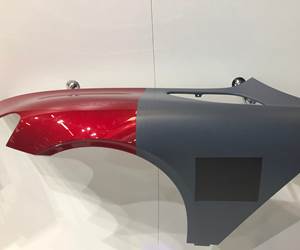Get ready for Composites 4.0!
It might seem like science fiction, but it must be our path if we are to make composites competitive.
- Wind/Energy
- Automotive
- IACMI
- Defense
- Carbon Fibers
- Composites 4.0
- Materials
- Fabrics/Preforms
- Pressure Vessels
- ATL/AFP
- Consumer
- Processes
- Resins
- Thermoplastics
- Aerospace
- Mass Transit
- Electric Vehicles
- Reinforcements
- Markets
- Marine
- Injection/Overmolding
- Construction
- Hi-Temp Resins
- Additive Manufacturing
- Prepregs
In April, I participated for the first time in the Hannover Fair, perhaps the largest industrial technology exhibition in the world. The week-long event filled 16 halls and featured innovations in energy, automation, robotics, sensing and other topics. I was in the USA Research and Technology Pavilion, representing the Institute for Advanced Composites Manufacturing Innovation (IACMI, Knoxville, TN, US) in the National Network for Manufacturing Innovation booth. On display there was the full-scale Shelby Cobra electric vehicle which features a body 3D-printed using a carbon fiber-reinforced thermoplastic. It attracted a lot of attention because most people are unfamiliar with 3D printing items larger than a shoebox!
I did get the opportunity to walk around the show one day. I found only a few advanced composites applications or technologies on display; most notably, the use of carbon fiber components to make equipment lighter, thus able to move parts around with less inertia. However, what fascinated me most were two over-arching technological themes: The Internet of Things (IoT), and Industry 4.0 (Industrie 4.0 in Germany, where the term was coined in 2011). Although these themes are not composites specific, they will have an enormous impact on the advanced composites industry — assuming we choose to leverage the power of the tools they represent.
So what do we mean by IoT and Industry 4.0? We’re talking industrial revolutions: The first was defined by water and steam power, the second by the assembly line and electricity, and the third by robots and computers. This is the fourth. Because the terms IoT and Industry 4.0 are relatively new, definitions are fluid, but Wikipedia provides a cogent starting point: Industry 4.0 is a collective term that embraces a number of contemporary automation, data exchange and manufacturing technologies. It draws together Cyber-Physical Systems, the Internet of Things and the Internet of Services. Industry 4.0 facilitates the vision and execution of a Smart Factory. Within the modular, structured Smart Factories of Industry 4.0, Cyber-Physical Systems monitor physical processes, create a virtual copy of the physical world and make decentralized decisions. Over the Internet of Things, these Cyber-Physical Systems communicate and cooperate with each other and with humans in real time, and via the Internet of Services, both internal and cross-organizational services are offered and used by participants in the value chain.
These technologies will be able to reduce the costs of traditional metallic fabrication a little, but there is a lot of opportunity for cost reduction in the world of composites. As we all know, the high cost of advanced composites is a major barrier to market penetration. For composites, smarter, faster layup and molding processes with improved quality and reliability will be able to meet required production rates in industrial and aerospace markets. Most significantly, there will be a great reduction in rework and inspection and greater consistency.
At Hannover, two halls were filled with sensors that can be connected in all kinds of ways, with wireless transmission clearly the path of the future. Accurate, miniature, and most important, increasingly cheaper, these sensors can measure angles, position, dimensions, temperatures, pressures, impedance, light, electrical resistance — almost any physical state of a material — and relay that information to a Big Data collection repository. This is largely the realm of the Internet of Things — stuff that can talk to other stuff. But data are just that — data. What we need is to transform that data into information and then, using knowledge of the physical relationships between these inputs, make decisions based on them. In real time. This is where Industry 4.0 kicks in.
So, for composites, this means we can verify immediately the fiber orientations of every ply laid by a machine and whether or not all the expected fiber tows are present. We can know the exact state of cure within a mold and if it is where we expect it to be. And we can know if the process is drifting. The software in the system makes the appropriate adjustment(s) to the process — inserting a missing tow before the next ply is laid up, or changing the mold temperature, the injection rate, the catalyst ratio, mold pressure, vacuum level or some other parameter — without human intervention. The machines are able to do this because we have developed a virtual twin of the process via simulation.
Throw in light weight, along with fast robots to move materials and parts through the process, and automatically inspect them and get them onto the next step — assembly or shipment — then you have the factory of the future. It might seem like science fiction, but it must be our path if we are to make composites the most competitive materials of the next generation.
Related Content
Plant tour: BeSpline/Addcomp, Sherbrooke, QC, Canada
Composites automation specialist increases access to next-gen technologies, including novel AFP systems and unique 3D parts using adaptive molds.
Read MoreComposites end markets: Infrastructure and construction (2024)
Composites are increasingly used in applications like building facades, bridges, utility poles, wastewater treatment pipes, repair solutions and more.
Read MoreNew standard specification supports non-metallic FRP rebar
ASTM International standard D8505 enables further integration of FRP rebar into infrastructure applications.
Read MoreThe state of recycled carbon fiber
As the need for carbon fiber rises, can recycling fill the gap?
Read MoreRead Next
Plant tour: A&P, Cincinnati, OH
A&P has made a name for itself as a braider, but the depth and breadth of its technical aptitude comes into sharp focus with a peek behind usually closed doors.
Read MoreModeling and characterization of crushable composite structures
How the predictive tool “CZone” is applied to simulate the axial crushing response of composites, providing valuable insights into their use for motorsport applications.
Read More“Structured air” TPS safeguards composite structures
Powered by an 85% air/15% pure polyimide aerogel, Blueshift’s novel material system protects structures during transient thermal events from -200°C to beyond 2400°C for rockets, battery boxes and more.
Read More








.jpg;maxWidth=300;quality=90)












